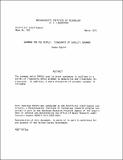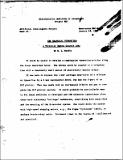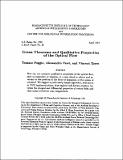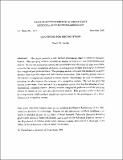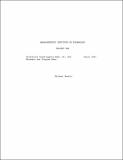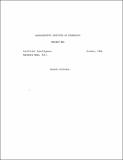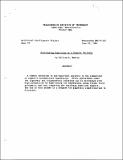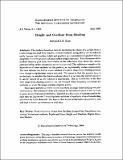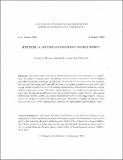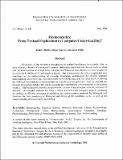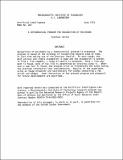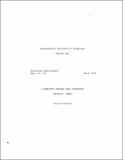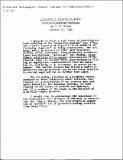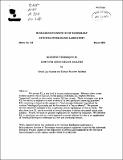Browsing AI Memos (1959 - 2004) by Title
Now showing items 430-449 of 1217
-
GPSG-Recognition is NP-Hard
(1985-03-01)Proponents of generalized phrase structure grammar (GPSG) cite its weak context-free generative power as proof of the computational tractability of GPSG-Recognition. Since context-free languages (CFLs) can be parsed ... -
Grammar as a Programming Language
(1976-10-01)This paper discusses some student projects involving generative grammars. While grammars are usually associated with linguisitics, their usefuleness goes far beyond just "language" to make different domains. Their ... -
Grammar for the People: Flowcharts of SHRDLU's Grammar
(1973-03-01)The grammar which SHRDLU uses to parse sentences is outlined in a series of flowcharts which attempt to modularize and illuminate its structure. In addition, a short discussion of systemic grammar is included. -
Grammar Rewriting
(1991-12-01)We present a term rewriting procedure based on congruence closure that can be used with arbitrary equational theories. This procedure is motivated by the pragmatic need to prove equations in equational theories where ... -
The Graphical Typewriter: A Versatile Remote Console Idea
(1964-01-01)It would be useful to develop a combination typewriter-plotter along the lines described below. The device could be coupled to a telephone line with a reasonably small amount of electronics -- mostly relays. -
Green Theorems and Qualitative Properties of the Optical Flow
(1991-04-01)How can one compute qualitative properties of the optical flow, such as expansion or rotation, in a way which is robust and invariant to the position of the focus of expansion or the center of rotation? We suggest a ... -
The Greenblatt Chess Program
(1969-04-01)Since mid-November 1966 a chess program has been under development at the Artificial Intelligence Laboratory of Project MAC at M.I.T. This paper describes the state of the program as of August 1967 and gives some of the ... -
Grouping For Recognition
(1989-11-01)This paper presents a new method of grouping edges in order to recognize objects. This grouping method succeeds on images of both two- and three- dimensional objects. So that the recognition system can consider first ... -
HAKMEM
(1972-02-01)Here is some little know data which may be of i nterest to computer hackers. The items and examples are so sketchy that to decipher them may require more sincerity and curiosity than a non-hacker can muster. Doubtless, ... -
Hardware and Program Memo About SERVO
(1967-03-01)SERVO is intended as an engineering and programming analyzing and debugging aid for use with devices connected through the input and output multiplexers to the PDP-6. Cannel numbers and values to output, as well as ... -
Hardware Memo - Input Multiplexer Status
(1966-10-01)Note: Computer control of Input Multiplexer and Output Sample and Hold is available when clock and test switches on the I/O box are in "Computer Input" and "Computer Output" positions, respectively. Manual operation of the ... -
Hash-Coding Functions of a Complex Variable
(1964-06-25)A common operation in non-numerical analysis is the comparison of symbolic mathematical expressions. Often equivalence under the algebraic and trigonometric relations can be determined with the high probability by hash-coding ... -
Height and Gradient from Shading
(1989-05-01)The method described here for recovering the shape of a surface from a shaded image can deal with complex, wrinkled surfaces. Integrability can be enforced easily because both surface height and gradient are represented. ... -
Herbert: A Second Generation Mobile Robot
(1988-01-01)In mobile robot research we believe the structure of the platform, its capabilities, the choice of sensors, their capabilities, and the choice of processors, both onboard and offboard, greatly constrains the direction of ... -
Hermeneutics: From Textual Explication to Computer Understanding?
(1986-05-01)Hermeneutics, a branch of continental European philosophy concerned with human understanding and the interpretation of written texts, offers insights that may contribute to the understanding of meaning, translation, ... -
A Heterarchical Program for Recognition of Polyhedra
(1972-06-01)Recognition of polyhedra by a heterarchical program is presented. The program is based on the strategy of recognizing objects step by step, at each time making use of the previous results. At each stage, the most obvious ... -
A Heuristic Program that Constructs Decision Trees
(1969-03-01)Suppose there is a set of objects, {A, B,...E} and a set of tests, {T1, T2,...TN). When a test is applied to an object, the result is wither T or F. Assume the test may vary in cost and the object may vary in probability ... -
A Heuristic Program to Solve Geometric Analogy Problems
(1962-10-01)A program to solve a wide class of intelligence-test problems of the "geometric-analogy" type ("figure A is to figure B as figure C is to which of the following figures?") is being constructed. The program, which is written ... -
Heuristic Techniques in Computer Aided Circuit Analysis
(1975-03-01)We present EL, a new kind of circuit analysis program. Whereas other circuit analysis systems rely on classical, formal analysis techniques, EL employs heuristic "inspection" methods to solve rather complex DC bias ... -
Hidden Clues in Random Line Stereograms
(1983-08-01)Successful fusion of random-line stereograms with breaks in the vernier acuity range has been previously interpreted to suggest that the interpolation process underlying hyperacuity is parallel and preliminary to ...



